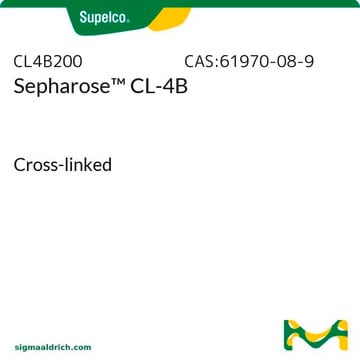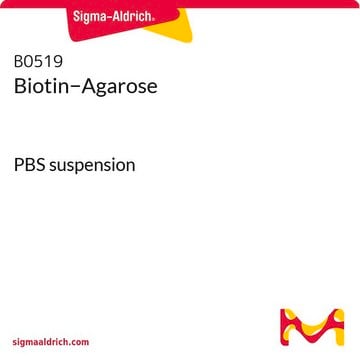GE17-0120-01
Sepharose™ 4B
Cytiva 17-0120-01, pack of 1 L
About This Item
Productos recomendados
envase
pack of 1 L
fabricante / nombre comercial
Cytiva 17-0120-01
matriz
4% agarose
tamaño de partícula
45-165 μm
cleaning in place
4-9
working range
4-9
InChI
1S/C24H38O19/c25-1-5-9(27)11(29)12(30)22(38-5)41-17-8-4-36-20(17)15(33)24(40-8)43-18-10(28)6(2-26)39-23(14(18)32)42-16-7-3-35-19(16)13(31)21(34)37-7/h5-34H,1-4H2/t5-,6-,7+,8+,9+,10+,11+,12-,13+,14-,15+,16-,17-,18+,19+,20+,21-,22+,23+,24+/m1/s1
Clave InChI
MJQHZNBUODTQTK-WKGBVCLCSA-N
¿Está buscando productos similares? Visita Guía de comparación de productos
Categorías relacionadas
Descripción general
Aplicación
Sepharose™ CL gels are cross-linked derivatives of Sepharose™ 2B, Sepharose™ 4B and Sepharose™ 6B. The cross-linked form of Sepharose™ is chemically and physically more resistant than Sepharose™ itself, offering the same selectivity with better flow characteristics. Cross-linked Sepharose™ gels are resistant to organic solvents and are thus the choice for separations in organic solvents
Características y beneficios
- 4% Agarose gel filtration media.
- Proven base matrix for coupling affinity ligands
Almacenamiento y estabilidad
Nota de análisis
Información legal
Palabra de señalización
Warning
Frases de peligro
Consejos de prudencia
Código de clase de almacenamiento
3 - Flammable liquids
Certificados de análisis (COA)
Busque Certificados de análisis (COA) introduciendo el número de lote del producto. Los números de lote se encuentran en la etiqueta del producto después de las palabras «Lot» o «Batch»
¿Ya tiene este producto?
Encuentre la documentación para los productos que ha comprado recientemente en la Biblioteca de documentos.
Los clientes también vieron
Nuestro equipo de científicos tiene experiencia en todas las áreas de investigación: Ciencias de la vida, Ciencia de los materiales, Síntesis química, Cromatografía, Analítica y muchas otras.
Póngase en contacto con el Servicio técnico













